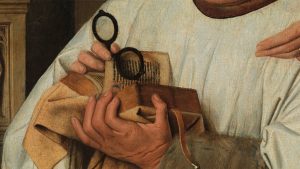 Appel à communication : « God is in the Details. The Art of Detail in the Middle Ages », 27th Annual Medieval Postgraduate Colloquium, Londres, The Courtauld Institute
Appel à communication : « God is in the Details. The Art of Detail in the Middle Ages », 27th Annual Medieval Postgraduate Colloquium, Londres, The Courtauld Institute
For Aby Warburg, God was in the details; for others they were the devil. From manuscript miniatures to carved altarpieces or richly decorated muqarnas , detail was highly valued in the Middle Ages. In different circumstances the deployment of detail displays, disguises and depends upon the materiality of objects, embedded in the woven structure of textiles, the techniques of Islamic metal inlay, and the varied receptivity to carved decoration of ivory, marble, alabaster and boxwood. The production of detail was demanding, often requiring fine materials, masterful skill, hours of time and technical innovation. Small things, then, as well as large, could speak to the sophistication and power of patrons, but did details also communicate in more subtle ways? Details could disrupt well-established iconographies and half-conceal subversive subtexts, or present subtle suggestions which only the most perceptive viewers would appreciate. Did details also affect scalar relationships between viewer and object, pointing beyond the material dimensions of the ordinary world? The production and reception of details are central to this colloquium.
The reception of detail also leads us to consider its place in the practice of art history. Close observation of apparently insignificant details lay at the heart of the connoisseurial, attribution-focused art history of the nineteenth century. More recently scholars have examined the cultural significance of detail, from Necipoğlu’s explication of the ‘scrutinizing gaze’ in Islamic art to Gell’s notion of ‘cognitive stickiness’. Others have closely engaged with detail in relation to craft, from Margaret Graves’ theory of the ‘intellect of the hand’ to Paul Binski’s explorations of the ‘human “poetics” of materials’. Gigapixel reproductions and microscopic analysis are also shaping art history today, a field which is ever more prone to specialization and micro-histories. But does this pursuit of detail distort the original viewing experience, or scholars’ capacity to frame questions in broad terms? Are there ways of reconstructing more historicised experiences of detail, through historical theories of vision and philosophies of the unseen? The Courtauld’s Medieval Postgraduate Colloquium offers the opportunity to delve into detail, in all its complex material, cultural and academic dimensions.
Speakers may consider the following, understood in the broadest geographical terms:
Material and Craft
- How were objects of great detail produced?
- How did materials affect the kinds of detail included?
- What was the role of detail in the celebration of skilled craftsmanship in the Middle Ages?
Meaning and Messages
- How was detail used to express subversive ideas or messages for specific people or groups?
- Was detail valued differently depending on viewers’ social, economic, religious backgrounds?
- How was the inclusion of details negotiated between patron, artist, architect, and craftsman?
- How might detail serve to prompt meditation or contemplation?
Perception and Reception
- Who had access to details, and in what conditions?
- How does the 21st-century viewer gauge the importance of relatively small or subtle details in a medieval work?
- What do primary sources—including medieval theories of vision and philosophies of the unseen—reveal about the value of detail?
- How does the close scrutiny of detail affect the viewer’s experience of an object or building?
Technology and Methodology
- How did medieval technological advances change the ability to create and see detail?
- How does modern technology enhance or impair our ability to see and interpret detail in medieval art and architecture?
- Can art historians lose sight of the entire object, or even broader art-historical issues, by focusing too closely on specific details and ‘micro-histories’?
This colloquium offers an opportunity for research students at all levels from universities across the United Kingdom and abroad to present, discuss and promote their research. We would also welcome unorthodox proposals, including short, ‘micro’ papers, and especially demonstrations of technologies related to the art-historical analysis of detail.
To apply, please send a proposal of up to 250 words for a 20-minute paper, or an alternative presentation, together with a CV to medievalcolloquium@courtauld.ac.uk no later than 13 February 2022. Please also state your preferences and constraints for presenting in person or remotely. Contributions may be available towards the cost of travel & accommodation.
Source : Courtauld Institute

Leave a Reply
You must be logged in to post a comment.